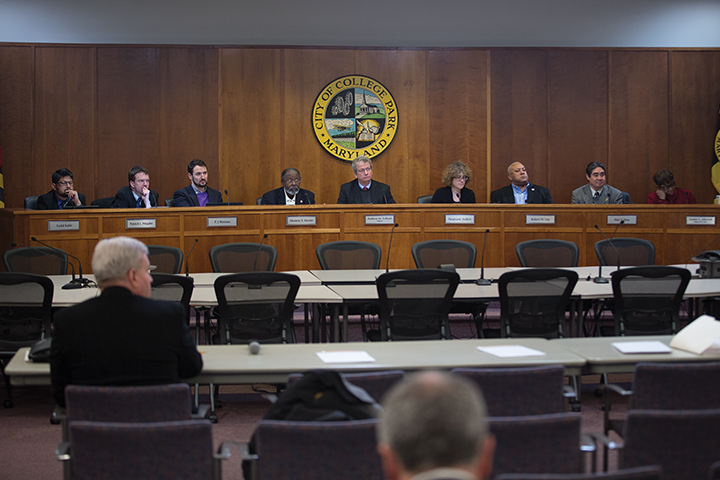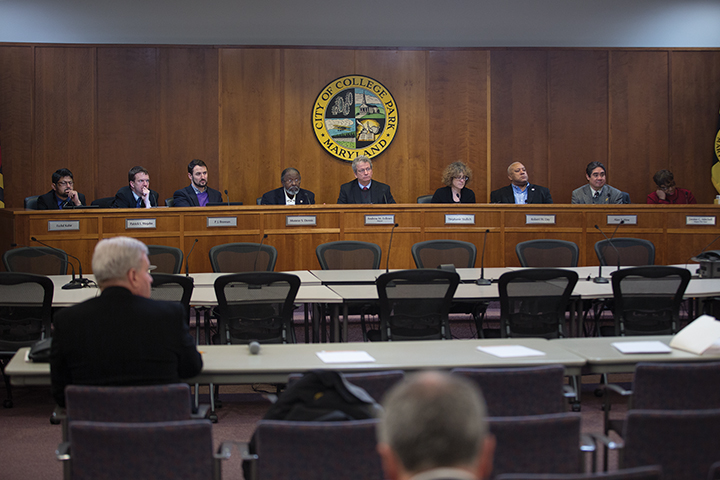In eight days, the College Park City Council must tell the State Highway Administration whether it wants to accept, reject or postpone a move to begin undergrounding utilities as part of a Route 1 redevelopment plan.
City officials are eager to set the project in motion, but they’re concerned about the $14 million price tag. To mitigate the cost, the council unanimously voted at the March 11 work session to send a letter to Prince George’s County Executive Rushern Baker requesting the county establish a tax increment financing district for the utilities project.
“We’re limited in terms of the amount that we can borrow as a city, so we are looking at different ways we would be able to fund that undergrounding,” District 1 Councilman Patrick Wojahn said.
If the county agrees to establish a TIF district, the city will issue bonds to generate the necessary funds to pay for the Route 1 project. The repayment of the bonds will come from the anticipated higher property taxes generated from the improvements.
The incremental higher taxes will be used to pay back the bonds, and once the bondholders are reimbursed, the city will retain the property tax revenue.
The county has agreed to put $4 million toward this project, leaving $10 million for the city to finance. But even if the county agrees to establish a TIF district in addition to the $4 million commitment, Wojahn said the city still would need more funding sources for this project.
“Four million dollars of funds towards the undergrounding — which is very generous and it certainly would help the goal — but it’s not enough, and it’s not enough even with the tax increment financing,” Wojahn said. “So we’re still looking at a significant gap we need to fill in order to accomplish the undergrounding.”
Terry Schum, city planning director, said she isn’t certain the county will agree to establishing a TIF district. While the city waits for a response, officials are looking into other financing options, such as a possible partnership with power company Pepco or other grants from the state or federal level.
“While we think it’s good for the city and the county, of course, because it helps facilitate redevelopment and it provides the public improvement needed to support the private development, the county, to my knowledge, has never … done tax increment financing on a district-wide basis. They do it on a project basis,” Schum said.
Without the city securing additional funding, District 1 Councilman Fazlul Kabir said he anticipates the council will not move forward with undergrounding utilities and instead will stick with the original Route 1 redevelopment plan.
In the original plan, the SHA planned to move utility poles a few feet back from the road, which also would cost the city several million dollars.
“It just seems unfortunate that instead of relocating them above ground, that we can’t take advantage of this opportunity to put them underground,” Schum said.
A study presented to Washington’s planning office by design and strategy firm Streetsense to evaluate the “essential elements of outstanding retail areas” found that every successful retail street had underground utilities, a fact Wojahn used to emphasize the benefits of this project.
“It’s something a lot of us on the council would like to see happen, but it’s difficult to see it forward with our current options,” Wojahn said. “I hope that we can find a way to do this.”
With the April 1 deadline approaching, the council has limited time to reach a decision — at least if they want to move forward without delay.
“If we see a possible path forward, there is a way we might be able to do this,” Wojahn said. “We’ve waited for decades to accomplish the rebuilding of Route 1. Waiting another month or two wouldn’t be the end of the world.”
The College Park City Council wants to underground utilities along Route 1 as part of a redevelopment plan. The project would cost about $14 million.





